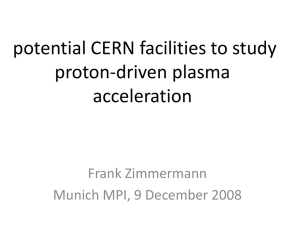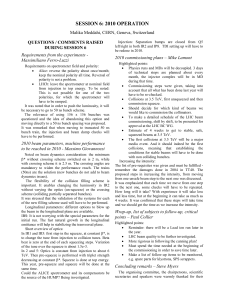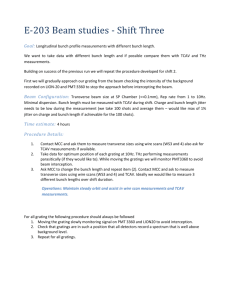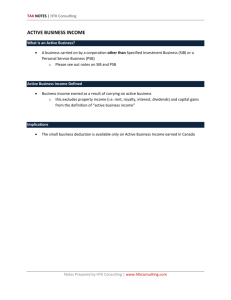The LHC Proton Beam
advertisement
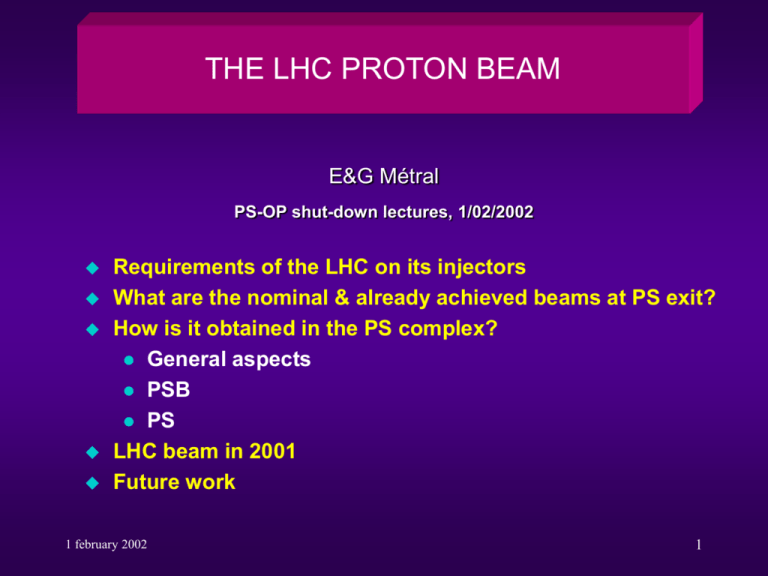
THE LHC PROTON BEAM E&G Métral PS-OP shut-down lectures, 1/02/2002 Requirements of the LHC on its injectors What are the nominal & already achieved beams at PS exit? How is it obtained in the PS complex? General aspects PSB PS LHC beam in 2001 Future work 1 february 2002 1 Requirements of the LHC on its injectors Choice of the nominal LHC parameters Energy E [TeV] Dipole field B [T] Luminosity -2 -1 L [cm s ] Harmonic number h Number of bunches kb Protons / bunch Nb Bunch spacing b.s [ns] emittances x&y norm,1 x, y [m] Long. emittance l2 [eVs] 1 february 2002 7 8.3 1034 35640 2808 1.11011 25 3.75 0.5 1 2 Requirements of the LHC on its injectors LHC project leader L. Evans Major upgrade needed all along the injector chain 1 february 2002 3 What are the nominal & already achieved beams at PS exit? Achieved 25 Nominal 25 84 84 72 72 1.11011 1.11011 25 25 2.5 3 Long. emittance l2 [eVs] 0.35 0.35 Total bunch length b [ns] Momentum spread 2 p/p 4 4 2.210-3 2.210-3 Energy E [GeV] Harmonic number h Number of bunches kb Protons / bunch Nb Bunch spacing b.s [ns] emittances x&y norm,1 x, y [m] The specifications are met in the PS complex 1 february 2002 4 How is it obtained in the PS complex? General aspects Main challenges High brightness & very short bunches Solutions Double-batch filling of the PS Lowers the space charge effects at PSB Increase of the PS injection energy Lowers the space charge effects at PS injection Multi splittings => bunch number, bunch spacing & emittance Bunch rotation to produce the desired bunch length 1 february 2002 5 PSB General aspects for PSB 2 consecutive cycles (LHC, TSTLHC) 1 bunch per ring (H1) Different possibility to fill the 6 buckets of the PS 2 PSB rings + 4 PSB rings, 2 times 3 PSB rings, 4 PSB rings + 2 PSB rings Multi-turn injection : 3 turns exactly (for homogeneous longitudinal distribution) Special tune due to large tune shift Double harmonics operation (bunch flattening) => decreases the space charge tune shift at injection Available controlled blow-up C16 (H9) No coupling between the transverse planes Standard settings of multipoles for resonance compensations 1 february 2002 6 Transfer PSB PS C805 Synchronization Non-standard bunch spacing at ejection to fit the PS H7 RF system t PS h 7 TrevPS 2290 327 ns 7 7 Adjustment with the phase offsets : BAx.PSYNCOFFSET (ring 3 is always used as the reference) Remember that the Timing used in that process is in H8 more difficulties to adjust the timing for the synchronization & for the instrumentation Ejection at 1.4 GeV fast extraction towards the PS through the BT/BTP transfer line 1 february 2002 7 PSB Beam parameters at PSB extraction Protons / bunch 1 february 2002 Achieved Nominal 1.4 10 12 1.32 10 12 Hor. emittance xnorm,1 [m] 2 .2 2 .5 Ver. Emittance ynorm,1 [m] 1 .8 2 .5 Long. emittance l2 [eVs] 1.4 1 .5 Tot. bunch length b [ns] 195 Momentum spread 2 p / p -3 (10 ) 2.2 195 2.45 8 PS General aspects Double-batch injection : separated by 1.2 s 6 bunches out of 7 buckets Longitudinal beam slicing complicated RF gymnastics PSB exit PS exit ~ 300 ns High brightness conservation careful control of collective effects, injection oscillations, working point, chromaticity, non-linearity extraction… 1 february 2002 9 at PS 1.4 GeV kinetic energy At low energy Inj42 at C170 1st injection => 2 or 3 bunches (H7) Transverse matching between PSB and PS, orbit correction... RF phase adjustment (PA.PDISC-H7) adjusted from the CB if the PSB extraction phase is correct Working point during the long flat-bottom Qh ~ 6.21 and Qv ~ 6.23 RMS current on low energy power supply Inj42 at C1370 2nd injection => 3 or 4 bunches (after the first batch ) Momentum adaptation PSB-PS => PSB synchro. made with PS beam Same frequency sent to the PSB for the same MRP as the first injection one & same PS magnetic field RF phase adjustment (PA.PDISC-H7) 1 february 2002 10 PS 1.4 GeV kinetic energy Head-Tail resistive-wall instability Intensity (1010 ) Beam-Position Monitor (20 revolutions superimposed) R signal I skew 0.33 A Time [ms] Time (20 ns/div) m 6 1 february 2002 I skew 0.4 A 11 PS Remember that the Timing of the second injection can also be adjusted by the Timing_f_t program 1 february 2002 12 PS 1.4 GeV kinetic energy 1.4 Gev after second injection Triple splitting 6 × 3 = 18 bunches H7 to H21 1 february 2002 13 C1563 PS Acceleration At transition : -jump + change of the chromaticity sign Longitudinal coupled-bunch instabilities between 6 and 20 GeV/c cured by controlled longitudinal blow-up Cavities 200MHz From 20 to 26 GeV/c, horizontal orbit correction => PR.GSDHZ15,60-OC At high energy (26 GeV/c momentum) Synchronization H1 => the worst 1st double splitting => 18 × 2 = 36 bunches (H42) 2nd double splitting => 36 × 2 = 72 bunches (H84) 1cavity 20MHz 1 cavity 40MHz 1 february 2002 14 PS ejection Orbit correction during the Bump Bump compensation in the RF phase loop system New ABS interface with virtual GFAs Without, the phase loop is not strong enough 1 cavity 40 MHz (H84) 2 cavities 80 MHz Bunch compression by a step voltage => longitudinal mismatch => bunch rotation and ejection after 1/4 of synchrotron period Ej 16 at C2395 Ejection at 26 GeV/c fast extraction towards the SPS through the TT2/TT10 transfer line b 16 ns 1 february 2002 b 4 ns with l 0.35 eVs 15 Inj at C169.8 PS Inj2 at C1369.8 Ej at C2395 1000 15000 1011Gauss at C160 B up at C1450 Transition at C1563 12576Gauss at C2120 900 13000 800 11000 600 9000 500 7000 400 Gauss protons nbr (e10) 700 5000 300 200 Blow up2 C1725=>C1825 3000 100 1000 0 Triple split. C1375 =>C1400 -100 100 Blow up1 C1400=>C1440 -1000 600 1100 Time [ms] 1600 2100 I [e10] B [Gauss] 1 february 2002 16 PS Lock of a frequency source on the BEAM PAX.SSYNCH1INT C2141 Start sync SPS Synchro H1 PAX.SD1SYNCSPS C2155 Start PL H84 C2363 Start fine sync Synchro H21 PAX.SD2SYNCSPS C2365 Start PL H42 C2318 350 13000 300 Ej at C2395 250 100 B(Gauss) V gp4 200 V gp5 V C20 150 V C40 V C80 b 50 0 2000 2050 2100 Start first Double split. Start cavity 20MHz C2258 1 february 2002 2150 2200 2250 2300 End cavity 10Mhz Start cavity 40mhz C2338 2350 10000 2400 End cavity 20Mhz Start GFA cavity 80mhz C2388 17 PS Start of the bunch rotation process Synchro with The extraction 1 february 2002 18 PS Ej at C2395 Start of the bump16 Start of PA.GSCOMP-BSW16 Ej –7.5ms = C2387.5 350 External restart For PA.GSV40 & PA.GSV80 By PAX.SBRH84 Ej –5.3ms = C2389.7 300 250 200 V C20 150 V C40 V C80 100 50 0 2380 2382 2384 End cavity 20Mhz Start GFA cavity 80mhz C2388 1 february 2002 2386 2388 2390 2392 2394 2396 Start cavity 80mhz ~ ej –100us 19 PS RF signals during extraction process Phase discri H21 Phase discri H42 1 february 2002 Other important signals on NAOS PA.PDISC-H84 PA.SYNCDISC-H21 PA.GSCOMP-BSW16 20 PS Longitudinal beam structure in the last turn of the PS 300 ns/div 30 ns/div 1 ns/div 1 february 2002 21 PS Only 1 measurement is still missing the transverse emittances in TT2 in the presence of bunch rotation Emittance measurements using the Semfils in TT2 without bunch rotation H - plane 1 february 2002 V - plane 22 PS Baseline drift on electrostatic pick-ups in TT2 Also observed in the PS Without solenoid With solenoid ~ 50-100 G Apparently the beam is not affected this is only a measurement problem for the PS (contrary to the SPS and LHC) 1 february 2002 23 SPS and LHC filling LHC Proton Injection Cycle (21.6 s) This cycle is repeated 12 times for each LHC ring. 3 or 4-batch cycles will be interleaved in the form 334 334 334 333 to fill each ring with a total of 2808 bunches. The LHC filling time will be 12 21.6 s = 4.3 minutes per ring 1 february 2002 24 SPS and LHC filling Bunch disposition in the LHC, SPS and PS 1 february 2002 25 LHC Beam in 2001 Blow up on the PSB machine Better low energy process in the PS machine New synchronization at extraction implemented Bunch stability better than 0.5ns at ejection (only measurable in CB) Better splitting at 26GeV/c (phase loop) Bunch to bunch intensity fluctuations <10% as required Coupling measurements at different energies H/V coupling at transition (tune crossing) H/V coupling at 26GeV/c 50 ns bunch spacing done Ultimate beam done 1 february 2002 26 LHC Beam in 2002 New B train (at the start up) Magnetic cycle to be reviewed LHC beam must be the first operation Working point at low energy Suppress the ripple on the PFW GFAs TTSM (type EPTTSM) to monitor the phase stability at extraction Test of a fast LHC cycle in the PS 1 february 2002 27 Fast LHC cycle 2.4 s - 26 GeV/c cycle for double-batch injection in the PS 14000 B new B Actuel 26 GeV/c flat-top 240ms (-15ms) 12000 Magnetic field [Gauss] 1st inj C160 2nd inj C840 eject C1710 end of cycle C2370 10000 8000 1st inj C170 2nd inj C1370 eject C2395 end of cycle C2350 6000 4000 2000 0 0 1200 2400 3600 time [ms] 1 february 2002 28 To find documentation This file N:\Psop\Doc\PS\Presentation\LHCBeam2002.ppt All the MD measurements N:\Psop\Archives\data\PS\&MDs\Lhc Beam reference on the WEB http://srv1ps/psop/cps/BeamRef/lhc/ 1 february 2002 29


